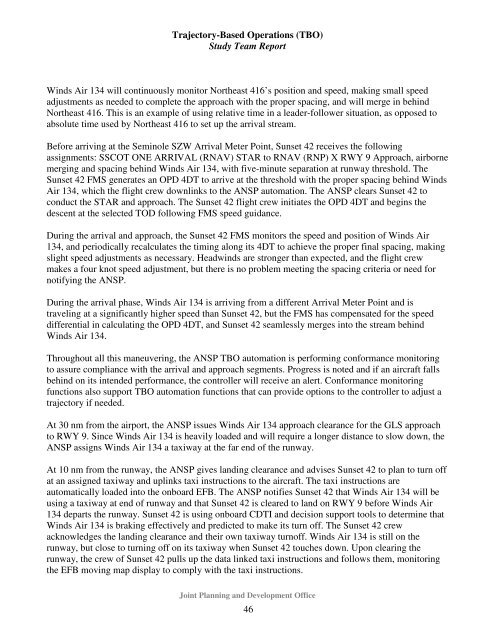Trajectory-Based Operations (TBO) - Joint Planning and ...
Trajectory-Based Operations (TBO) - Joint Planning and ...
Trajectory-Based Operations (TBO) - Joint Planning and ...
You also want an ePaper? Increase the reach of your titles
YUMPU automatically turns print PDFs into web optimized ePapers that Google loves.
<strong>Trajectory</strong>-<strong>Based</strong> <strong>Operations</strong> (<strong>TBO</strong>)<br />
Study Team Report<br />
Winds Air 134 will continuously monitor Northeast 416’s position <strong>and</strong> speed, making small speed<br />
adjustments as needed to complete the approach with the proper spacing, <strong>and</strong> will merge in behind<br />
Northeast 416. This is an example of using relative time in a leader-follower situation, as opposed to<br />
absolute time used by Northeast 416 to set up the arrival stream.<br />
Before arriving at the Seminole SZW Arrival Meter Point, Sunset 42 receives the following<br />
assignments: SSCOT ONE ARRIVAL (RNAV) STAR to RNAV (RNP) X RWY 9 Approach, airborne<br />
merging <strong>and</strong> spacing behind Winds Air 134, with five-minute separation at runway threshold. The<br />
Sunset 42 FMS generates an OPD 4DT to arrive at the threshold with the proper spacing behind Winds<br />
Air 134, which the flight crew downlinks to the ANSP automation. The ANSP clears Sunset 42 to<br />
conduct the STAR <strong>and</strong> approach. The Sunset 42 flight crew initiates the OPD 4DT <strong>and</strong> begins the<br />
descent at the selected TOD following FMS speed guidance.<br />
During the arrival <strong>and</strong> approach, the Sunset 42 FMS monitors the speed <strong>and</strong> position of Winds Air<br />
134, <strong>and</strong> periodically recalculates the timing along its 4DT to achieve the proper final spacing, making<br />
slight speed adjustments as necessary. Headwinds are stronger than expected, <strong>and</strong> the flight crew<br />
makes a four knot speed adjustment, but there is no problem meeting the spacing criteria or need for<br />
notifying the ANSP.<br />
During the arrival phase, Winds Air 134 is arriving from a different Arrival Meter Point <strong>and</strong> is<br />
traveling at a significantly higher speed than Sunset 42, but the FMS has compensated for the speed<br />
differential in calculating the OPD 4DT, <strong>and</strong> Sunset 42 seamlessly merges into the stream behind<br />
Winds Air 134.<br />
Throughout all this maneuvering, the ANSP <strong>TBO</strong> automation is performing conformance monitoring<br />
to assure compliance with the arrival <strong>and</strong> approach segments. Progress is noted <strong>and</strong> if an aircraft falls<br />
behind on its intended performance, the controller will receive an alert. Conformance monitoring<br />
functions also support <strong>TBO</strong> automation functions that can provide options to the controller to adjust a<br />
trajectory if needed.<br />
At 30 nm from the airport, the ANSP issues Winds Air 134 approach clearance for the GLS approach<br />
to RWY 9. Since Winds Air 134 is heavily loaded <strong>and</strong> will require a longer distance to slow down, the<br />
ANSP assigns Winds Air 134 a taxiway at the far end of the runway.<br />
At 10 nm from the runway, the ANSP gives l<strong>and</strong>ing clearance <strong>and</strong> advises Sunset 42 to plan to turn off<br />
at an assigned taxiway <strong>and</strong> uplinks taxi instructions to the aircraft. The taxi instructions are<br />
automatically loaded into the onboard EFB. The ANSP notifies Sunset 42 that Winds Air 134 will be<br />
using a taxiway at end of runway <strong>and</strong> that Sunset 42 is cleared to l<strong>and</strong> on RWY 9 before Winds Air<br />
134 departs the runway. Sunset 42 is using onboard CDTI <strong>and</strong> decision support tools to determine that<br />
Winds Air 134 is braking effectively <strong>and</strong> predicted to make its turn off. The Sunset 42 crew<br />
acknowledges the l<strong>and</strong>ing clearance <strong>and</strong> their own taxiway turnoff. Winds Air 134 is still on the<br />
runway, but close to turning off on its taxiway when Sunset 42 touches down. Upon clearing the<br />
runway, the crew of Sunset 42 pulls up the data linked taxi instructions <strong>and</strong> follows them, monitoring<br />
the EFB moving map display to comply with the taxi instructions.<br />
<strong>Joint</strong> <strong>Planning</strong> <strong>and</strong> Development Office<br />
46
















